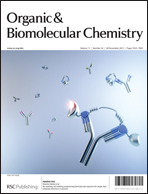An OFF–ON chemosensor for biological and environmental applications: sensing Cd2+ in water using catanionic vesicles and in living cells†
Abstract
A new OFF–ON fluorescent chemosensor (L1) for Cd2+ recognition based on a 5-chloro-8-hydroxyquinoline pendant arm derivative of 1,4,7-triazacyclononane ([9]aneN3) will be presented and its photochemical features in an MeCN–H2O 1 : 1 (v/v) mixture, in pure water, after inclusion within catanionic vesicles, and in living cells will be discussed. The coordination properties of L1 both in solution and in the solid state were preliminarily studied and its selectivity towards Cd2+versus a set of different metal ions (Cu2+, Zn2+, Cd2+, Pb2+, Al3+, Hg2+, Co2+, Ni2+, Mn2+, Mg2+, K+, Ca2+, Ag+, and Na+) was verified in MeCN–H2O 1 : 1 (v/v). In water, upon addition of increasing amounts of Cd2+ to L1 an enhancement of the fluorescence emission was detected. To overcome this serious drawback, L1 was dissolved in an innovative catanionic vesicular solution based on sodium bis(2-ethylhexyl) sulfosuccinate, a traditional surfactant, and 1-dodecyl-3-methylimidazolium bromide, an ionic liquid. When enclosed within the vesicle bilayers in water, L1 restored its fluorescence emission property upon addition of Cd2+. Remarkably, L1 enters the cellular membrane of living cells thus allowing the detection of intracellular Cd2+. These findings encourage the application of this new fluorescent chemosensor in real samples for histological and environmental analyses.


 Please wait while we load your content...
Please wait while we load your content...